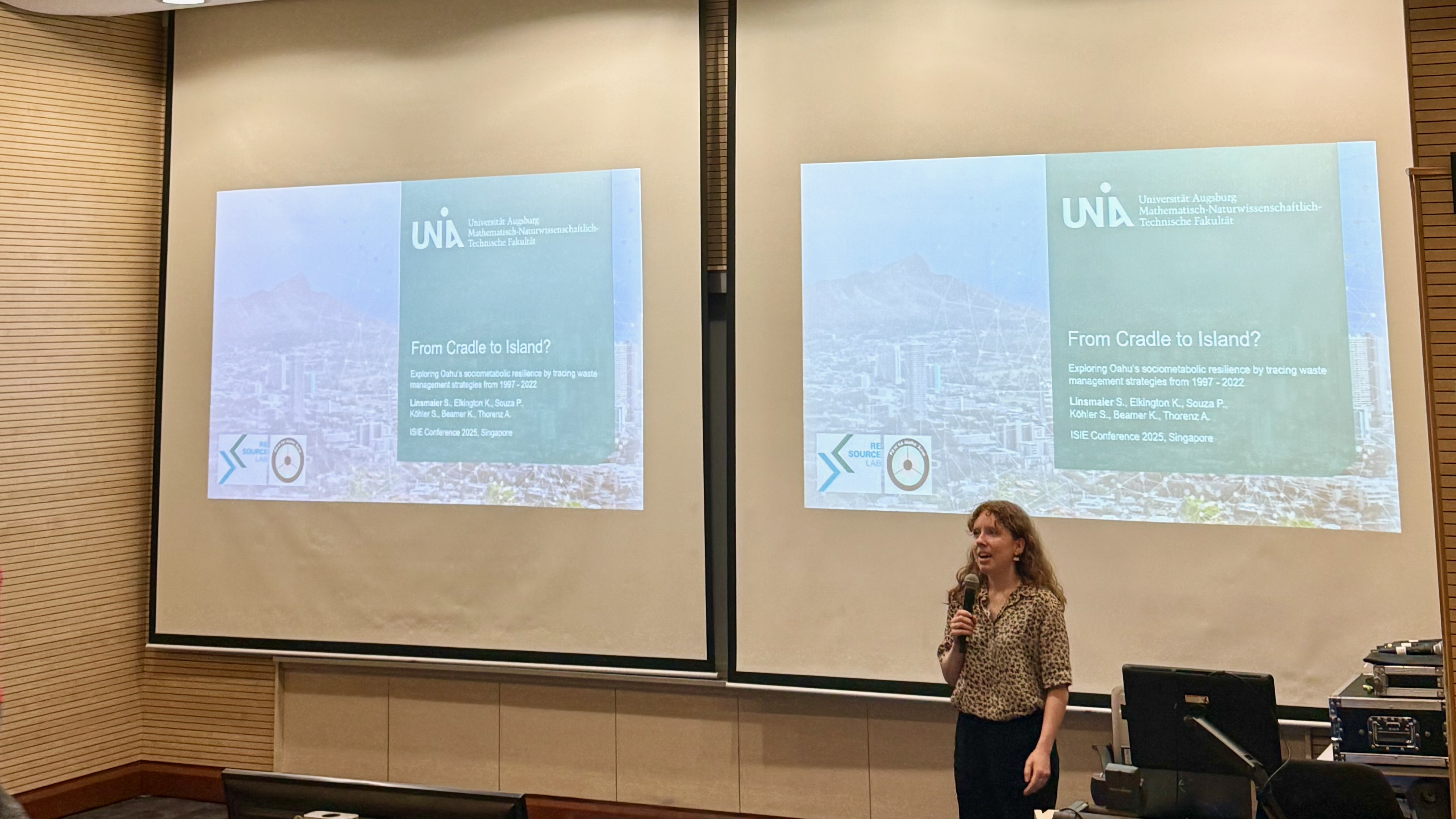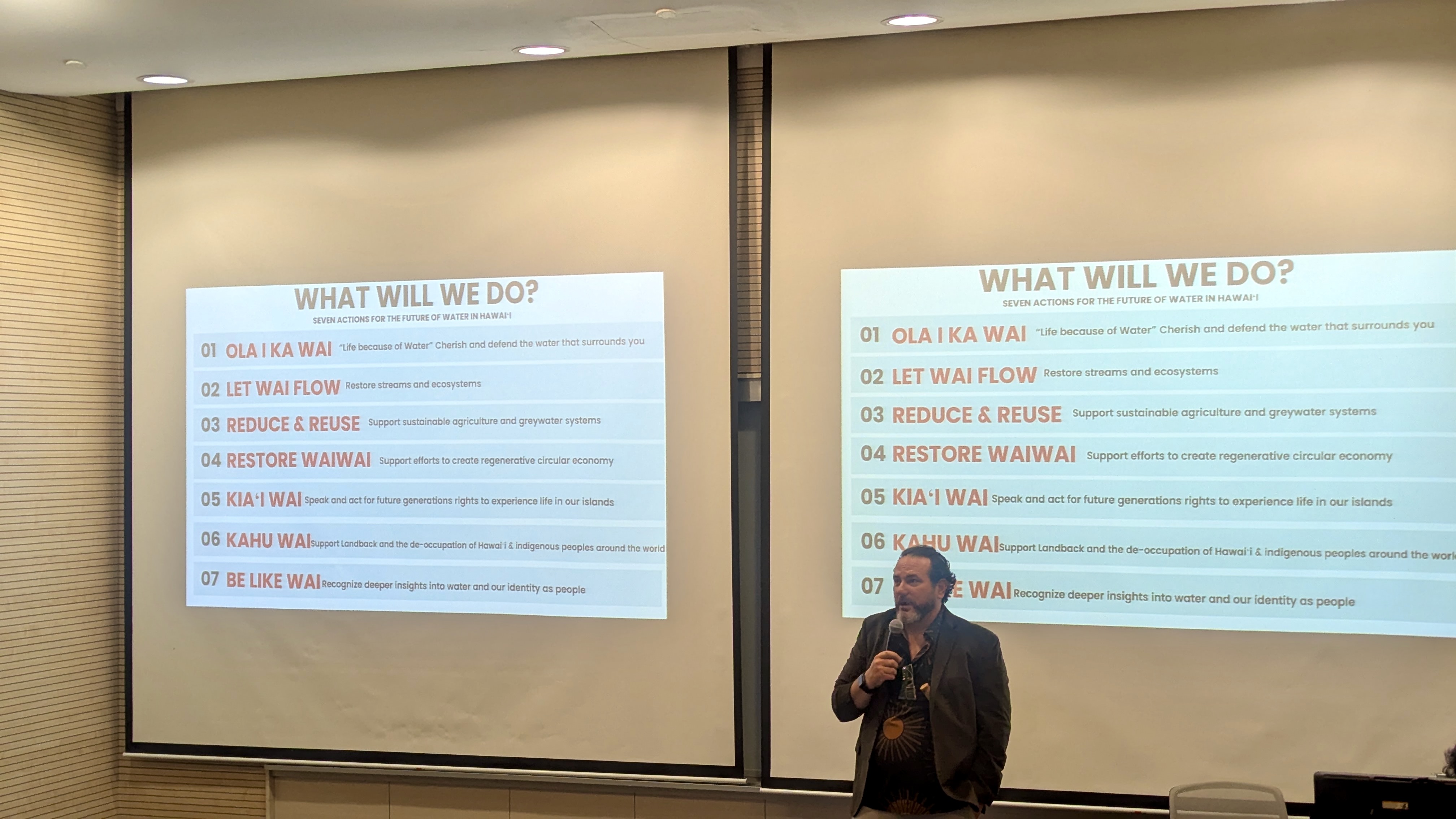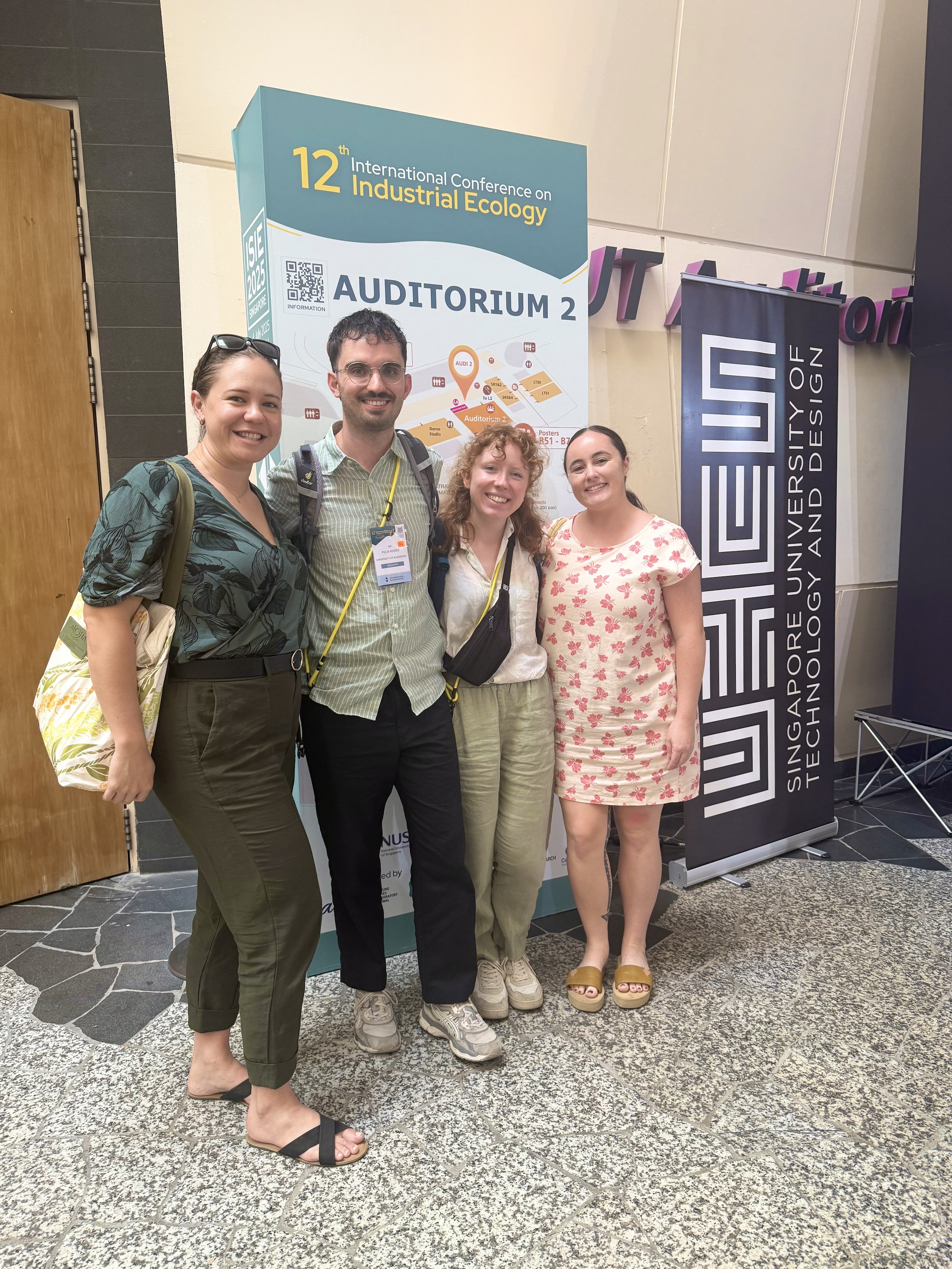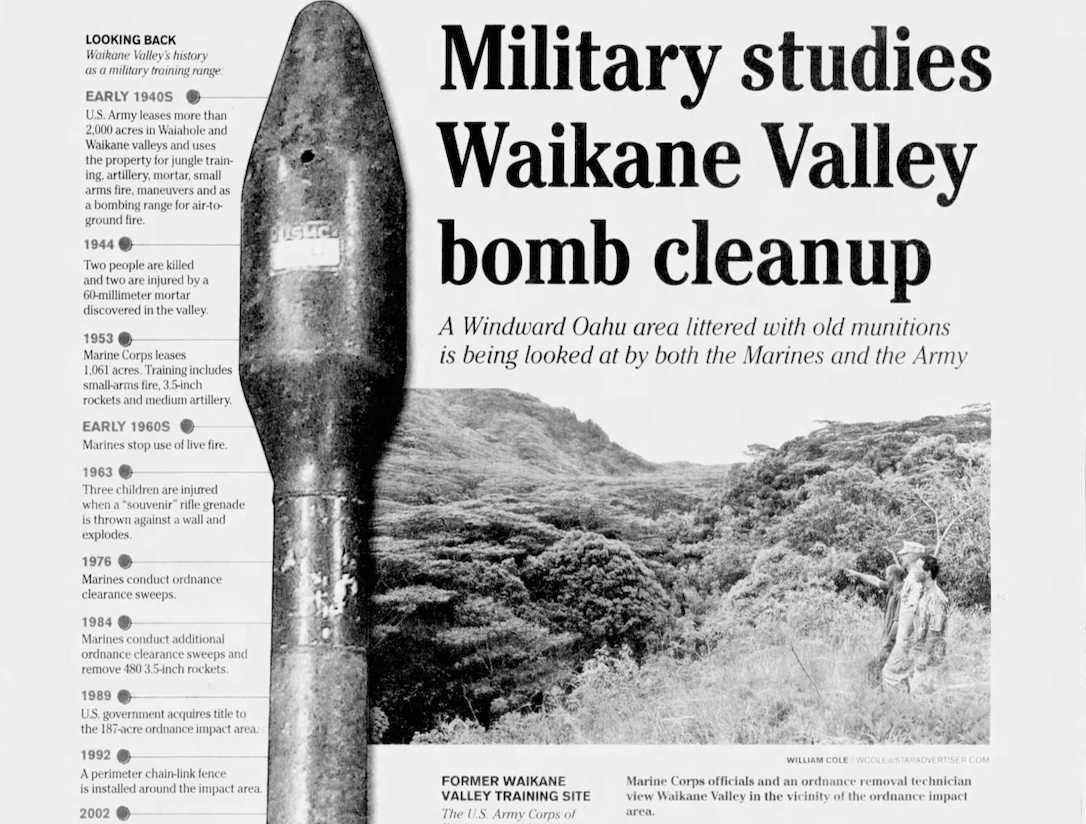At the beginning of July, some members of the PAʻA team traveled to Singapore for the 12th International Conference on Industrial Ecology, hosted by the International Society for Industrial Ecology (ISIE) at the National University of Singapore. Every year, the conference brings together researchers and practitioners from around the world to share cutting-edge approaches to industrial ecology – the science of designing industrial systems that mimic natural ecosystems.
PAʻA Representation at the Conference
The theme of this year’s conference was Interconnectivity, highlighting mutual dependencies between: industry, society, governance, the environment, the different scales of human settlements, and the circular material and political relations that are core to the worldview of industrial ecology. PAʻA was represented in two presentations:


These were part of a special session organized around strategies for resilient islands. This is the third gathering PAʻA has been a part of - the first was in Vienna, for the ISIE-SEM 2022 conference in Austria, and the second was the 11th International Conference in Leiden, Netherlands. Engaging with ISIE, its members, and its events is a chance for global knowledge exchange across a worldwide network of researchers and practitioners in the field, and an opportunity to demonstrate aloha ʻāina as a framework for sustainability and justice on a global platform.
Conference Highlights and Key Takeaways
Professor Linda Godfrey, Principal Scientist at the Council for Scientific and Industrial Research (CSIR) and Extraordinary Professor at North-West University in South Africa, delivered a keynote on “The Circular Economy as a Science, Technology and Innovation Priority: The Case of South Africa.” Godfrey provided a powerful reframing of how we understand circular economy transitions. She challenged the idea that circular economy is simply about waste management or recycling, emphasizing instead that it’s fundamentally about sustainable resource management and national resource security.
Her sobering statistics—that the global economy is only 6.9% circular and has actually declined from 9.1% in 2018 due to rising material extraction—underscored the urgency of systemic change. What made her presentation particularly compelling was her detailed exploration of South Africa’s comprehensive approach to circular economy implementation through partnerships between different industries, including their publicly available Waste RDI Roadmap, and initiatives transforming everything from sawdust to chicken feather waste into high-value products through partnerships with small businesses and universities.
Her emphasis that Circular Economy is a social imperative, and her question "What took us away from circularity?", resonated deeply with the Lab’s work on achieving social and environmental justice through aloha ʻāina, and bringing forward ancestral understandings of economy. Most importantly, her passionate assertion that universities and science are crucial to a transition to a Circular Economy further validates the essential role of academic research in not just studying circular economy principles, but actively supporting policy development and helping businesses de-risk circular interventions.
Professor Khoo Peng Beng, Head of the Architecture and Sustainable Design (ASD) pillar and Professor of Practice at SUTD, presented the concept of Humancity, a vision for urban design that prioritizes human well-being. Drawing from his background in architecture and home design, Khoo described his work as “love made visible”, the belief that designing something good for the world is fundamentally an act of love. His approach integrates architecture, nature, and life into building design with the goal of creating environments that promote hospitality and encourage "free choice, acceptance, respect for personal dignity, care and services to others through a design process that hosts the participation of all." Central to his philosophy is the intentional design of spaces that help people connect with nature, viewing justice as restorative in nature—about making something whole again. Referencing insights from Harvard's happiness research showing that positive relationships keep us happier longer, Khoo's Humancity framework demonstrates how thoughtful urban design can foster the social connections and environmental relationships essential for humans to flourish.
Emerging Trends in Industrial Ecology
Participating in this conference gave us the opportunity to experience and learn about compelling trends in the field of industrial ecology. Most striking was the pervasive integration of artificial intelligence and machine learning across virtually every sector. In a special session on Artificial Intelligence for Industrial Ecology, researchers found that the integration of AI within IE has grown rapidly in recent years to effectively address broader sustainability challenges (Gong et al., 2025). However, this rapid AI integration brings critical equity challenges that demand immediate attention.

Joe Bozeman, from the College of Engineering at Georgia Institute of Technology, presented a recently published article that highlights recent demands for “equity tools and frameworks to be integrated through the research and design life cycle … with an emphasis on reducing inequity in artificial intelligence (AI) and machine learning (ML) applications” (Bozeman et al., 2024). This is to address the tendencies for algorithms and datasets to create or reinforce unfair bias and equity. For industrial ecology practitioners, this means that AI-driven analyses of resource flows, environmental impacts, or circular economy strategies may inadvertently perpetuate or amplify existing socioecological inequities.
Another notable trend is the field’s growing concern represented at the conference in addressing social equity and justice within industrial systems. Researchers are (finally) recognizing that sustainable industrial systems must be socially sustainable systems. This represents a notable departure from earlier industrial ecology work primarily focused on biophysical flows. This was represented in multiple studies, including on resource requirements for decent living standards to analyses of environmental burdens on disadvantaged communities. It was also represented in an encouraging increase of real-world implementation, from industrial symbiosis networks in diverse global contexts to municipal-scale circular economy initiatives. Presentations demonstrated a growing movement from theoretical frameworks toward practical tools for transformation, with researchers working directly with cities, companies, and communities to implement circular and regenerative systems at scale.
When Politics Undermine Possibility
The experience of learning about the innovative sustainability efforts around the world at ISIE, while the US undertakes unprecedented policy reversals threatening decades of environmental progress, was profoundly unsettling. Ambitious projects promoting environmental stewardship and economic prosperity, and an opportunity to promote indigenous perspectives for the same from Hawaiʻi, was shadowed by the stark reality of a political climate we are forced to operate in where environmental programs and research are being systematically dismantled. Since January, the Trump administration has gut climate programs, unraveled environmental regulations, and removed safety nets to protect communities from climate-driven disasters. Further, Trump’s attack on universities reveal a deliberate approach to eliminate university-based research that historically informed environmental regulations, using diversity, equity, and inclusion (DEI) concerns as justification for broader cuts to environmental and climate science.
Hawaiʻi remains subject to these federal policies because of ongoing US occupation. This colonial reality leaves us vulnerable to these decisions being made thousands of miles away by an administration hostile to indigenous sovereignty, environmental protection, climate change and inclusivity. More than 2,000 people lost their jobs locally due to federal cuts. Nearly $90 million in funding for Hawaii and Pacific region farms and food system organizations have been frozen or cut, affecting local farmers' capacity to grow food to alleviate food insecurity and support food banks and schools. By April of this year, nearly 50 projects totaling $36 million at UH had been frozen or terminated, affecting programs spanning medicine, climate science, agriculture, and education.
The juxtaposition of the innovative collaboration of the ISIE conference and the regressive policy landscape in the US underscores the challenge and urgency of our work. While global researchers and practitioners advance toward more equitable and circular systems, the current political moment demands that we not only continue this vital research, but also strengthen our networks of collaboration and knowledge exchange. The ancestral wisdom of aloha ʻāina that PAʻA brings to international forums like ISIE offers a crucial reminder that true sustainability has always been about reciprocity and regeneration. As we face an uncertain future, it is imperative to maintain connections of shared knowledge and collective resilience that can sustain transformative work, even in hostile political climates. The path forward requires us to hold both the vision of what’s possible, and the determination to protect and advance working toward it despite the challenges ahead.
Sources:
Alonso, J. (2024). How the battle over DEI shook out in 2024 and what’s to come. Inside Higher Ed | Higher Education News, Events and Jobs. https://www.insidehighered.com/news/faculty-issues/diversity-equity/2024/12/16/how-battle-over-dei-shook-out-2024-and-whats-come
Bender, M., Mizuo, A., & Caires, E. (2025, April 22). “Victim of our own success”: University of Hawaiʻi projects lose $36M in federal funding. Hawai’i Public Radio; HAWAII. https://www.hawaiipublicradio.org/local-news/2025-04-22/university-of-hawaii-projects-lose-36m-and-counting-in-federal-funding
Dance, S. (2025, July 5). How the Trump administration is already cutting off climate research. The Washington Post. https://www.washingtonpost.com/climate-environment/2025/07/05/trump-cuts-climate-research/
Grist Staff. (2025, July 30). Trump’s environmental policies are reshaping everyday life. Here’s how. Grist. https://grist.org/politics/trumps-environmental-policies-are-impacting-your-daily-routine/
KHON2. (2025, Feb. 28). Federal cuts lead to more than 2K loss of local jobs. KHON2. https://www.youtube.com/watch?v=KoFWG00SMAY.
Machado, J. (2025, March 31). In Hawaii, where 90% of food is imported, farmers who offset imbalance now face cuts. NBC News. https://www.nbcnews.com/news/asian-america/hawaii-farmers-trump-cuts-rcna198550
Molfetas, M. (2025, July 2). Trump’s Scorched Earth Environmental Policies Will Harm Us All. Currentaffairs.org; Current Affairs. https://www.currentaffairs.org/news/trumps-scorched-earth-environmental-policies-will-harm-us-all
Temple, J. (2025, June 2). The Trump administration has shut down more than 100 climate studies. MIT Technology Review. https://www.technologyreview.com/2025/06/02/1117653/the-trump-administration-has-shut-down-more-than-100-climate-studies/








